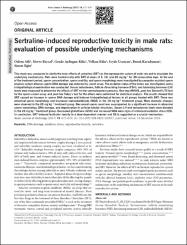| dc.contributor.author | Atlı Eklioğlu, Özlem | |
| dc.contributor.author | Baysal, Merve | |
| dc.contributor.author | Aydoğan Kılıç, Gözde | |
| dc.contributor.author | Kılıç, Volkan | |
| dc.contributor.author | Uçarcan, Şeyda | |
| dc.contributor.author | Karaduman, Abdullah Burak | |
| dc.contributor.author | Ilgın, Sinem | |
| dc.date.accessioned | 2019-10-19T16:02:47Z | |
| dc.date.available | 2019-10-19T16:02:47Z | |
| dc.date.issued | 2017 | |
| dc.identifier.issn | 1008-682X | |
| dc.identifier.issn | 1745-7262 | |
| dc.identifier.uri | https://dx.doi.org/10.4103/1008-682X.192637 | |
| dc.identifier.uri | https://hdl.handle.net/11421/13923 | |
| dc.description | WOS: 000413790500010 | en_US |
| dc.description | PubMed ID: 27976631 | en_US |
| dc.description.abstract | This study was conducted to clarify the toxic effects of sertraline (SRT) on the reproductive system of male rats and to elucidate the underlying mechanisms. Rats were treated orally with SRT at doses of 5, 10, and 20 mg kg(-1) for 28 consecutive days. At the end of the treatment period, sperm concentration, sperm motility, and sperm morphology were investigated by computer-assisted sperm analysis system whereas sperm DNA damage was detected by comet assay. The oxidative status of the testes was investigated, and a histopathological examination was conducted. Serum testosterone, follicle-stimulating hormone (FSH), and luteinizing hormone (LH) levels were measured to determine the effects of SRT on the spermatogenesis process. One-way ANOVA, post-hoc Dunnett's T3 test for the sperm comet assay, and post-hoc Tukey's test for the others were performed for statistical analysis. The results showed that SRT caused an increase in sperm DNA damage and induced histopathological lesions in all groups treated with SRT. There was abnormal sperm morphology and increased malondialdehyde (MDA) in the 10 mg kg(-1) treatment group. More dramatic changes were observed in the 20 mg kg(-1) treatment group. Decreased sperm count was accompanied by a significant increase in abnormal sperm morphology, DNA damage, and degeneration in cellular-tubular structures. Serum LH and testosterone levels were elevated in the 20 mg kg(-1) treatment group. Decreased glutathione (GSH) and increased MDA were signs of enhanced oxidative stress (OS). In conclusion, SRT induced testicular toxicity in a dose-dependent manner and OS is suggested as a crucial mechanism. | en_US |
| dc.description.sponsorship | Anadolu University Scientific Research Projects Commission [1404S128] | en_US |
| dc.description.sponsorship | This study was supported by the Anadolu University Scientific Research Projects Commission under the grant no. 1404S128. | en_US |
| dc.language.iso | eng | en_US |
| dc.publisher | Wolters Kluwer Medknow Publications | en_US |
| dc.relation.isversionof | 10.4103/1008-682X.192637 | en_US |
| dc.rights | info:eu-repo/semantics/openAccess | en_US |
| dc.subject | Dna Damage | en_US |
| dc.subject | Oxidative Stress | en_US |
| dc.subject | Reproductive Toxicity | en_US |
| dc.subject | Sertraline | en_US |
| dc.title | Sertraline-induced reproductive toxicity in male rats: evaluation of possible underlying mechanisms | en_US |
| dc.type | article | en_US |
| dc.relation.journal | Asian Journal of Andrology | en_US |
| dc.contributor.department | Anadolu Üniversitesi, Eczacılık Fakültesi, Farmasötik Toksikoloji Anabilim Dalı | en_US |
| dc.identifier.volume | 19 | en_US |
| dc.identifier.issue | 6 | en_US |
| dc.identifier.startpage | 672 | en_US |
| dc.identifier.endpage | 679 | en_US |
| dc.relation.publicationcategory | Makale - Uluslararası Hakemli Dergi - Kurum Öğretim Elemanı | en_US] |
| dc.contributor.institutionauthor | Atlı Eklioğlu, Özlem | |
| dc.contributor.institutionauthor | Aydoğan Kılıç, Gözde | |
| dc.contributor.institutionauthor | Kılıç, Volkan | |
| dc.contributor.institutionauthor | Uçarcan, Şeyda | |
| dc.contributor.institutionauthor | Ilgın, Sinem | |


















